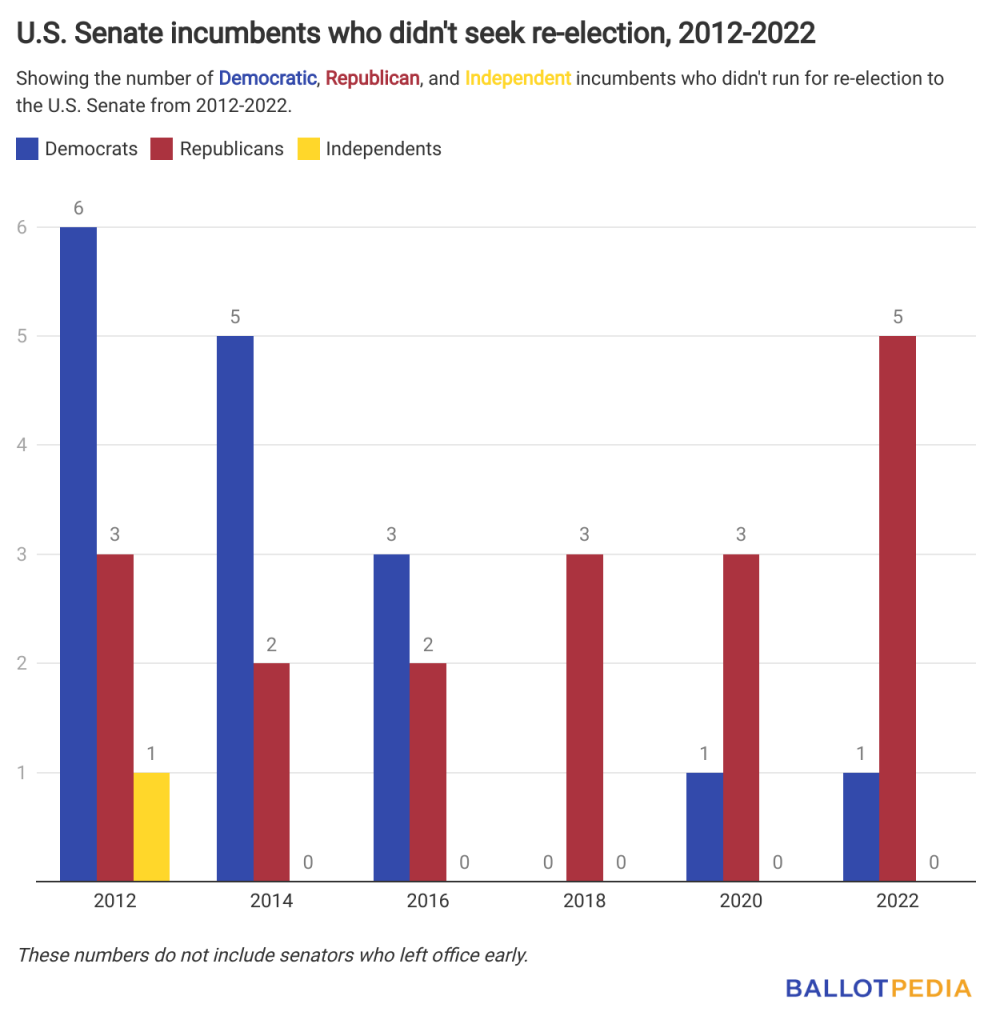Elections to the United States Senate will be held on November 8, 2022. Thirty-four of the 100 seats are up for regular election. Those elected to the U.S. Senate in the 34 regular elections will begin six-year terms on January 3, 2023.
Two special elections are also scheduled for November 8. One special election will be held to fill the final four years of Sen. Jim Inhofe’s (R-Okla.) six-year term that began in 2021. As a result, both of Oklahoma’s U.S. Senate seats will be up for election this year.
The other special election will be held to fill the final weeks of the six-year term that Vice President and former Sen. Kamala Harris (D-Calif.) was elected to in 2016. This U.S. Senate seat is also up for regular election in 2022, meaning a total of 35 seats are up for election this year.
Following the 2020 Senate elections and the January 2021 runoffs in Georgia, control of the chamber was split evenly for the first time since 2001 and for the fourth time in U.S. history. This gave Vice President Kamala Harris a tie-breaking vote, and Democrats control of the U.S. Senate via a power-sharing agreement.
Heading into the 2022 Senate election, the chamber is still split 50-50, with Republicans holding 50 seats, Democrats holding 48, and two independent senators caucusing with Democrats. Republicans need a net gain of one seat to win control of the chamber.
Of the 35 seats up for election this year, Democrats hold 14 and Republicans hold 21.
Aside from Inhofe, six incumbents — one Democrat and five Republicans — are not seeking re-election in 2022. They are:
- Roy Blunt (R-Mo.)
- Richard Burr (R-N.C.)
- Patrick Leahy (D-Vt.)
- Rob Portman (R-Ohio)
- Richard Shelby (R-Ala.)
- Pat Toomey (R-Pa.)
The five Republican incumbents not running for re-election are the most in a decade. In total, the six incumbents not seeking re-election this year are two more than in 2020.

Five races—three for seats held by Democrats and two for seats held by Republicans—are rated as Toss-ups by the Cook Political Report, Inside Elections, or Sabato’s Crystal Ball. They are:
- Arizona, incumbent Mark Kelly (D)
- Georgia, incumbent Raphael Warnock (D)
- Nevada, incumbent Catherine Cortez Masto (D)
- Pennsylvania, incumbent Pat Toomey (R) (not seeking re-election)
- Wisconsin, incumbent Ron Johnson (R)
Republicans are defending two Senate seats in states Joe Biden (D) won in the 2020 presidential election: Pennsylvania and Wisconsin. Democrats are not defending any Senate seats in states Donald Trump (R) won in 2020.
Four of the 34 seats up for regular election this year changed party hands the last time they were up for election.
Two of those seats, Illinois and New Hampshire, changed party hands in 2016, the last time they were up for regular election:
- Illinois—Tammy Duckworth (D) defeated incumbent Mark Kirk (R). Duckworth’s margin of victory was 15.1%.
- New Hampshire—Maggie Hassan (D) defeated incumbent Kelly Ayotte (R). Hassan’s margin of victory was 0.1%.
The other two, Arizona and Georgia, changed party hands in 2020 and 2021 after special elections were held in those states:
- Arizona — Mark Kelly (D) defeated incumbent Martha McSally (R) in a special election in 2020. Kelly’s margin of victory was 2.4%, and he was the first Democrat to win this seat since 1962.
- Georgia — Raphael Warnock (D) defeated incumbent Kelly Loeffler (R) in a special election that went to a runoff in 2021. Warnock’s margin of victory was 2.1%, and he was the first Democrat to win this seat since 2000.
Eleven of the seats up for election in 2022 were won by fewer than ten percentage points the last time they were up for election. Of those, seven were won by fewer than five percentage points, four held by a Democrat, and three held by a Republican.
Hassan’s margin of victory of 0.1% over Ayotte in New Hampshire’s 2016 Senate race was the closest, while Sen. John Hoeven’s (R-N.D.) margin of victory of 61.5% over Eliot Glassheim (D) in the 2016 North Dakota Senate race was the largest.
In 11 states with Senate seats up for election in 2022, the seat is currently held by a senator of a different party than the governor. Six seats held by Republican senators in states with Democratic governors are up. Five seats held by Democratic senators in states with Republican governors are up.
Four states with Senate seats up for election in 2022 have senators from different parties in the 117th Congress. Vermont has one Democratic senator and one independent senator who caucuses with Democrats, so three states with seats up for election have senators in different caucuses: Ohio, Pennsylvania, and Wisconsin.
There are seven states in the 117th Congress with senators from different parties, the fewest number of states with split Senate delegations in history.
Learn More






